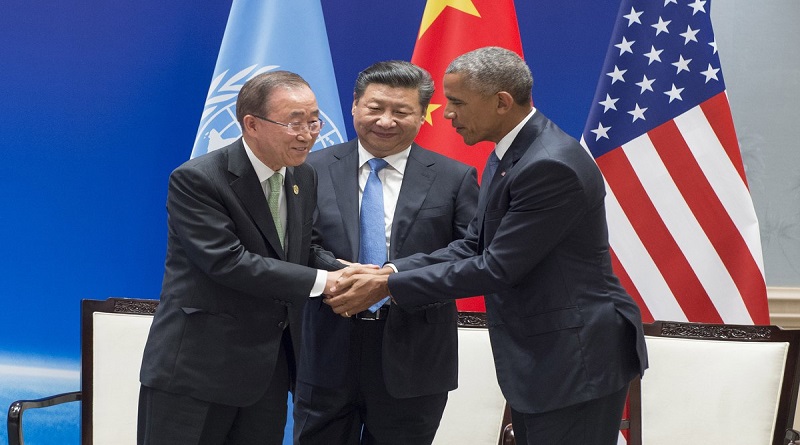China, US ratify Paris Agreement
The world’s top two emitters of greenhouse gases that represent nearly 40 per cent of global greenhouse emissions, China and the United States, today ratified the Paris Agreement which brought its rapid entry into force a big step closer.
“I would like today to thank China and the United States for ratifying this landmark agreement—an agreement on which rests the opportunity for a sustainable future for every nation and every person,†said Patricia Espinosa, Executive Secretary of the UN Framework Convention on Climate Change (UNFCCC).
“The earlier that Paris is ratified and implemented in full, the more secure that future will become, “she added.
The Paris Agreement enters into force on the 30th day after the date on which at least 55 Parties to the Convention accounting in total for at least an estimated 55 % of total global emissions have deposited their instruments of ratification, acceptance, approval or accession with the UN Depositary, in New York.
Today’s announcement by President Barack Obama and President Xi Jinping, in which both countries have announced they have deposited their instruments of ratification with the UN Secretary-General, puts the balance at just over 39 percent of the global total, based on the information from countries provided to the UN in accordance with the decision related to entry into force of the Paris Agreement.
“Bringing the Paris Agreement into force underlines that the momentum and international solidarity witnessed in 2015 continues into 2016 among big and small nations and among rich and poorer countries,†said Ms Espinosa.
“The UN Secretary General’s special event in New York on 21 September offers a further, focused opportunity for others to join this wave of ambition and optimism towards a better and sustainable world,†she added.
HFCs and Aviation
China and the United States also announced today that they were working together to secure a comprehensive and ambitious amendment of a sister treaty—the Montreal Protocol—when governments meet in Kigali, Rwanda in October.
The amendment is aimed at managing down the use of chemicals called Hydroflurocarbons (HFCs) that are now being used in refrigeration systems such as air conditioners and which are potent greenhouse gases in their own right.
The two countries said they wanted to secure not only an internationally-agreed phase-down of HFCs but an early ‘freeze’ date so that the phase-down starts sooner rather than later.
Meanwhile the United States and Chinese leaders also announced backing for action on aviation emissions under the International Civil Aviation Organization (ICAO) at its meeting later this month.
Under ICAO, governments will decide whether to agree a market-based mechanism that can assist in encouraging aircraft operators to bring down greenhouse gases from planes.
China and the United States said today that they plan to be early participants in a voluntary pilot phase if the decision goes through at the ICAO conference.
“I would like to commend China and the US for these two additional announcements. While the Paris Agreement is the main vehicle for action on climate change, it is clear that all international agreements need to work in tandem in order to realize our shared goals and aims,†she said.
The new announcements by China and the United States come in advance of the G20 Summit and the next round of UN climate negotiations—known as COP22—to be held in Marrakech, Morocco in November.
UN Secretary-General Ban Ki-moon invited leaders from all countries to New York to deposit their instruments of ratification, acceptance, approval or accession. The event also provides an opportunity to any country to publicly commit to do so.
In his invitation, Mr Ban said: “The next step in our collective journey to a low-carbon, climate-resilient future is to ensure the rapid entry into force of the Paris Agreement.â€
The objective of the Paris Agreement is to limit global warming well below 2°C and as close to 1.5°C as possible, to increase economic and social ability to adapt to extreme climate, and to direct the scale and speed of global financial flows to match the required path to very low-emission, climate-resilient development.
Along with the Sustainable Development Goals (SDGs) and the Sendai Framework for Disaster Risk Reduction, Paris forms part of a new and universal vision for a sustainable future around which the global community converged in 2015.
The unity of common purpose captured across these three agreements will now need to leverage an unprecedented scale and depth of national and international cooperative action involving all actors at all levels and in all regions of the world.
UN Secretary-General, while receiving the legal instruments said, “ Today, I am honoured to receive the legal instruments for joining the Paris Agreement from China and the United States.The leadership and close collaboration of both countries was pivotal to the successful conclusion of the climate change negotiations in Paris in December.
“Together, China and the United States represent nearly 40 per cent of global greenhouse gas emissions.
“Now, by formally joining the Paris Agreement, you have added powerful momentum to the drive for the Agreement to enter into force this year.
“With China and the United States making this historic step, we now have 26 countries who have ratified and 39 per cent of global emissions accounted for, to be exact.
“We just need another 29 countries representing 16 per cent of global emissions to bring this Paris Agreement into force. I am hopeful and optimistic that we can do it before the end of this year and before my term as Secretary-General of the United Nations ends.†He said
Similarly, the United Nations Environment Programme (UNEP) head, Erik Solheim, in a statement following the joint announcement by China and the United States on the Paris Agreement said,”This announcement is hugely important. The leadership of China and the United States is crucial to taking the Paris Agreement forward. They bring significant additional momentum to keeping global warming under 2 degrees.
“And by putting the well-being of our planet at the top of the agenda, the two largest economies in the world are also showing that our economic future is low-carbon and green.
“The fight against climate change remains difficult and urgent, but having heavy-hitters like China and the US on your side is extremely heartening.”




